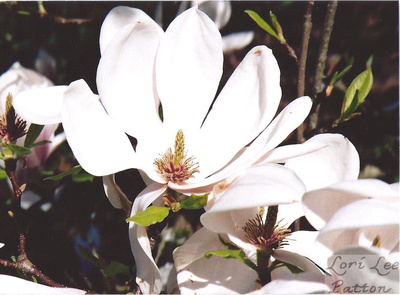Magnolias: Prehistoric Blooms in Modern Times
My interest in magnolias began as a child living off of Magnolia Blvd. in Los Angeles’ San Fernando Valley. There was a large southern magnolia tree in my backyard, which dropped its creamy, fragrant petals throughout the hot summer months. Those petals, deliciously scented and soft, were always out of my grasp until they floated down to the ground. I had no idea then that magnolias are believed to be one of the most ancient flowering plants, dating back millions of years. Following is a brief account of these amazing trees and how they have survived for eons.
Currently, magnolias are native to two areas of the world: the eastern Americas, from Canada south to Brazil, and eastern Asia, including China and Japan. However, they were originally much more widespread, encircling the Arctic regions before the first ice age. Fossils of magnolias have been discovered in Idaho dating back to the Miocene epoch 17 to 20 million years ago. Even more research suggests that magnolias were part of the ancient plant life that lived on Laurasia before it was divided into North America and Eurasia. This combination of climate change and continental drift accounts for the unusual distribution of the species.
Modern distribution of magnolias in gardens around the world began in 1687 when British missionaries to the American colonies sent back plants to London. A sweet bay magnolia in Virginia was the first to travel across the Atlantic followed by the southern magnolia around 1730. Magnolias were named after Pierre Magnol, a prominent French botanist in the late 17th century. Next the Asian magnolias were collected in China and Japan and taken to Britain around 1790. While the American magnolias are evergreen and produce large white flowers continuously through the summer, the Asian species are deciduous and flower profusely in spring. They also resemble lilies and appear in a variety of colors besides white, including pink and purple. These Asian magnolias were so popular in Europe that horticulturalists quickly set about hybridizing. The most important of these hybrids were the soulangeanas, created by Etienne Soulange-Bodin in 1820, a French cavalry officer for Napoleon. Since these robust beginnings, magnolia hybrids continue to be produced by breeders around the world.
Magnolias are currently found throughout America and are the state flower of Louisiana and Mississippi. Southern magnolias like the one at my childhood home continue to flourish around Los Angeles. Asian magnolias, which are better adapted to cooler climates, are commonly seen in the Pacific Northwest. The photograph “Magnolia Blossom” shown above was taken at Hoyt Arboretum in Portland, Oregon. The arboretum contains a superb collection of Asian magnolias that bloom in spring. From their first appearance millions of years ago to the thousands of different varieties available today, it seems magnolias have discovered the secret to longevity: an exquisite beauty that belies their strong endurance.
Sources
Gardiner, Jim. Magnolias: A Gardener’s Guide. Portland: Timber Press, 2000.
Tudge, Colin. The Tree: A Natural History of What Trees Are, How They Live, and Why They Matter. New York: Three Rivers Press, 2006.

